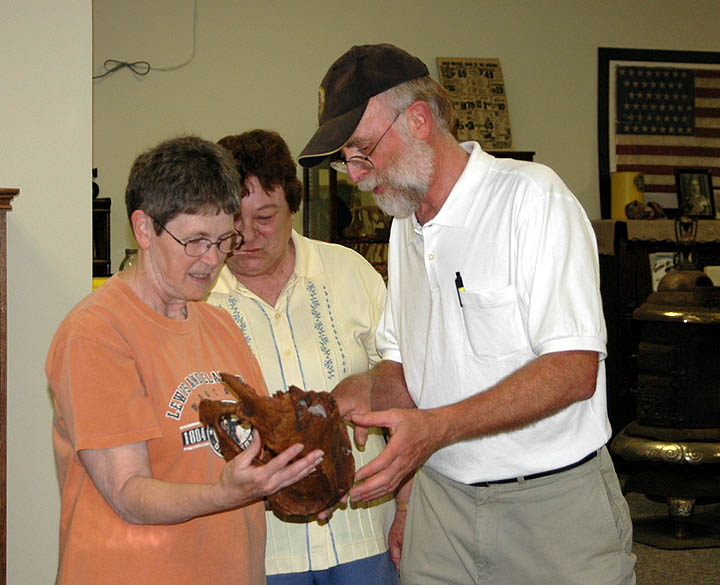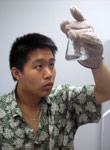 Holmes and I showed the sloths to an enthusiastic bunch of high school students last week and talked about paleontology as part of the University of Iowa’s Secondary Student Training Program (SSTP). The 19 students, juniors and seniors, some from as far away as Florida and Texas, were on campus for 6 weeks participating in an intense immersion in science research, with the cooperation of labs all across campus. Thanks to William Swain, Director SSTP and JSHS programs, Division of Continuing Education, for making the arrangements. We’re hoping to see a few of them at our next dig. . . . Dave
Holmes and I showed the sloths to an enthusiastic bunch of high school students last week and talked about paleontology as part of the University of Iowa’s Secondary Student Training Program (SSTP). The 19 students, juniors and seniors, some from as far away as Florida and Texas, were on campus for 6 weeks participating in an intense immersion in science research, with the cooperation of labs all across campus. Thanks to William Swain, Director SSTP and JSHS programs, Division of Continuing Education, for making the arrangements. We’re hoping to see a few of them at our next dig. . . . Dave
Author Archives: David
getting a late start today
Currently raining. 1/2″ last night shouldn’t pose a problem for the berm we built yesterday but it would be nice to have the ground dry out a little bit for walking around. Scattered lightning around us now too that has to move off before we go out. The forecast says all of this should be gone in a couple of hours and we can look forward to nice steamy afternoon of excavating. Will cleared a large area for us yesterday–hate to see all of his work wasted. Dave
the dig is on
Holmes and I are here in Shenandoah. We drove over last night from Iowa City with long-time MNH volunteer Aaron Last. Will be joined by dig-veterans Will Mott, Rob MacAfee and Lee McNair this AM. Despite an inch of rain on Saturday, the creek is still down and the forecast is good (chance of scattered showers tomorrow). Tuesday is scheduled to be an equipment day with most of the morning and early afternoon being spent by Will clearing the muck and moving the berm. Most of the volunteers are coming in Wednesday to excavate . . . . Dave
A shot in the dark
 Using a single bone to estimate the weight of an extinct animal, like we did last month, beats consulting the Psychic Hotline, but not by much. Scientists usually start with a weight-bearing bone like the femur. Unfortunately, fossil skeletons are usually incomplete and the bones fragmentary. When nothing else is available they look to tooth dimensions, jaw length, the thickness of a bone’s cortex, even the width of a joint (Scott, 1990). . . the equations are as numerous as the techniques for measuring the bones or the pieces thereof. (photo borrowed from)
Using a single bone to estimate the weight of an extinct animal, like we did last month, beats consulting the Psychic Hotline, but not by much. Scientists usually start with a weight-bearing bone like the femur. Unfortunately, fossil skeletons are usually incomplete and the bones fragmentary. When nothing else is available they look to tooth dimensions, jaw length, the thickness of a bone’s cortex, even the width of a joint (Scott, 1990). . . the equations are as numerous as the techniques for measuring the bones or the pieces thereof. (photo borrowed from)
Shenandoah Open House
About 300 people came to see the toddler skeleton and other special exhibits at the Open House in the Greater Shenandoah Historical Society May 29-30.
Thanks to Harold Decuir, President of the Board of Directors, Sallie Brownlee, Museum Director, and the rest of the museum board and volunteers for hosting us.
Saylorville photos

A sloth weight debate
 We now have an official estimate for the weight of our adult sloth courtesy of Greg McDonald—2,829 pounds. We had assumed it was bigger than the average Megalonyx (2,400 lbs., McDonald, 2005) from the relative size of the teeth, but this confirms it and provides our first absolute number using a formal estimating technique based on the femur.
We now have an official estimate for the weight of our adult sloth courtesy of Greg McDonald—2,829 pounds. We had assumed it was bigger than the average Megalonyx (2,400 lbs., McDonald, 2005) from the relative size of the teeth, but this confirms it and provides our first absolute number using a formal estimating technique based on the femur.
sloth program saturday
The Iowa Academy of Science Speaker Series at the Saylorville Visitor Center begins this Saturday, June 20th at 2:00 p.m. This event is open to the public free of charge and children are encouraged to attend.
Title: The Tarkio Valley Iowa Giant Ground Sloths: Life and Death in the Ice Ages.
Ground sloths may be extinct but they aren’t dead. The footsteps of these recently-departed elephant-sized Ice Age giants continue to echo through Iowa’s woodlands with important implications for today and the future under global warming. Holmes A. Semken, Jr. Emeritus Professor of Geoscience , University of Iowa, and Principle Investigator on the Tarkio Valley Sloth Project and David Brenzel, Co-PI, will discuss the excavation, which has been on-going since 2003, recovering the world’s only Jefferson’s sloth-family, including the most complete adult and second-most complete juvenile of the species ever found, and research progess to-date. Join David Brenzel and Holmes Semken as they tell the story of the Tarkio Valley Iowa excavation. The presentation will include a “show and tell” display of bones that children and adults will enjoy.
The Iowa Academy of Science is a 501 (c) (3) non-profit organization promoting science research, science education, the public understanding of science, and awards excellence in these endeavors.
We hope to see you Saturday at the Saylorville Visitor Center for this informative presentation. Bring the entire family.
Craig Johnson, Executive Director
Iowa Academy of Science
175 Baker Hall
University of Northern Iowa
Cedar Falls, IA 50614-0508
Movers and shakers
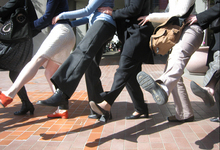 Walking on campus last month I spotted an acquaintance I had long overlooked—a Kentucky Coffee tree, Gymnocladus dioicus. It’s small and easy to miss most of the year, but one characteristic stood out—the ear-sized seedpods that had clung to its branches well into the Spring. Early American caffeine addicts ground up its large seeds to make a coffee substitute.
Walking on campus last month I spotted an acquaintance I had long overlooked—a Kentucky Coffee tree, Gymnocladus dioicus. It’s small and easy to miss most of the year, but one characteristic stood out—the ear-sized seedpods that had clung to its branches well into the Spring. Early American caffeine addicts ground up its large seeds to make a coffee substitute. 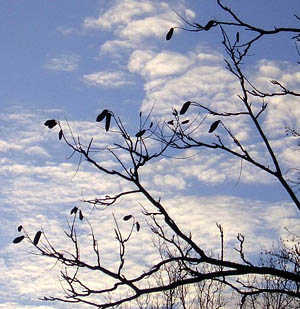 If they got a buzz it wasn’t from caffeine–a novel amino acid makes up 5% of the seed contents (dry weight), probably toxic to the Bruchid beetles that plague most other Leguminosae (Janzen, 1969), but a welcome winter snack for a hungry mastodon or ground sloth. G. dioicus shows all indications of being an ice age orphan–left hanging by its normal dispersers (Barlow, 2000). Native Americans may have saved the tree from extinction by spreading the seeds for food or perhaps to use for recreation (Van der Linden and Farrar, 1984). (tree photo borrowed from)
If they got a buzz it wasn’t from caffeine–a novel amino acid makes up 5% of the seed contents (dry weight), probably toxic to the Bruchid beetles that plague most other Leguminosae (Janzen, 1969), but a welcome winter snack for a hungry mastodon or ground sloth. G. dioicus shows all indications of being an ice age orphan–left hanging by its normal dispersers (Barlow, 2000). Native Americans may have saved the tree from extinction by spreading the seeds for food or perhaps to use for recreation (Van der Linden and Farrar, 1984). (tree photo borrowed from)
Photos from Greg McDonald’s May 2009 visit
More photos taken during Greg McDonald’s visit May 6-9, 2009. These are from his work in the lab May 7, and his special presentation to project volunteers that evening, prior to his public lecture.
Many thanks to Greg for his highly productive visit and exciting presentations–public and behind-the scenes. Watch for lots of follow-up in the near future. Can hardly wait for Greg to return. . . . Dave
More press about the new sloth
Some nice press about the new sloth discovery in Futurity, a new blog about breakthroughs at America’s research universities.
New fossil CT scans
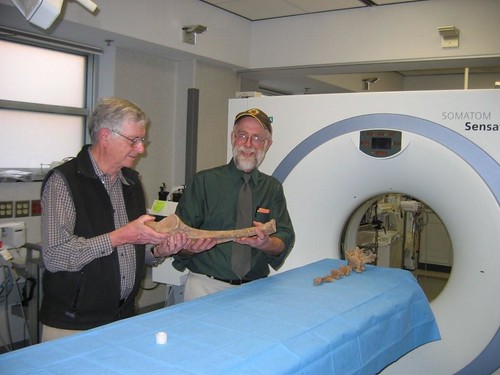 We’ll never be able to say enough about the amazing cooperation we’ve received from every University of Iowa department we’ve approached for help in analyzing the sloth fossils. That’s especially true of the Iowa Comprehensive Lung Imaging Center (ICLIC), which has given us access to one of the most advanced x-ray computed tomography (CT) imaging machines in the county to scan some of our sloth bones. The Siemens high speed, high resolution, multi-slice scanner is one of the few in the country devoted entirely to human and animal research.
We’ll never be able to say enough about the amazing cooperation we’ve received from every University of Iowa department we’ve approached for help in analyzing the sloth fossils. That’s especially true of the Iowa Comprehensive Lung Imaging Center (ICLIC), which has given us access to one of the most advanced x-ray computed tomography (CT) imaging machines in the county to scan some of our sloth bones. The Siemens high speed, high resolution, multi-slice scanner is one of the few in the country devoted entirely to human and animal research.

